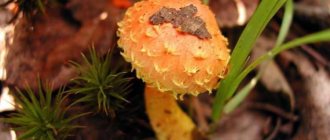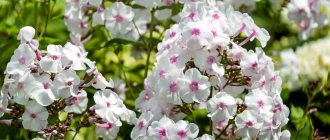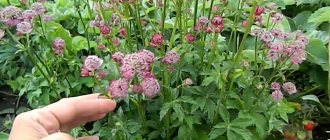Loading…
Loading…
Each gardener has his own best varieties of phlox. Some people like proud, tall bushes with large inflorescences. Others prefer compact plants that grow just over half a meter. Most gardeners prefer perennials without the hassle of planting seedlings every year. And there are also connoisseurs who do not find it a burden to renew their flower beds every spring with new plantings of annual phlox.
It is perhaps difficult to select the truly best species among the huge variety of these delicate flowers. They are all good and beautiful in their own way. Tall and low, early and late, large and small - phloxes still remain charming. Today we have selected for you a small collection of these brightly flowering plants. We hope that it will help both novice flower growers and experienced phlox lovers make their choice. So, we present to your attention the best varieties and varieties of phlox.
general characteristics
The name “Phlox” translates as “fiery flower,” which is justified by its bright, flashy colors. In the color scheme of the plant there are all kinds of variations of colors and shades, monochromatic and two-color, with strokes or eyes in the center of the bud. It belongs to the Sinyukhov family, has more than 70 species and a lot of varieties and hybrids (about 1500 pieces).
The height of the bushes ranges from 10 to 150 cm, the shoots are divided into creeping, erect and ascending. In the wild, it is often found on rocky mountains and slopes; North America is considered its homeland. It has been cultivated in the temperate climate of Russia for quite a long time and enjoys unprecedented prestige, especially among summer residents and residents of country houses. It is not demanding in terms of care, but to grow it in the garden you need to become familiar with the plant’s temperament, choose the right variety that is suitable for the climate, and create favorable conditions.
The most colorful flowers
Exclusive phloxes, species and varieties, photos of which can be found in the article, are famous for the unusual color of their petals.
Here are some examples of such plants:
- The Alyonushka variety has soft crimson flowers and a bright core.
- Phloxes called Success have an original center in the form of a small star and a bright purple petal color with a pink edging.
- Dutch phlox Bright Ice has pink flowers with a carmine tint inside.
- Terry phlox impresses with its relief and rare color. The creamy inflorescences of this exotic flower have a slight greenish tint.
- Peppermint Twist features petal patterns that clearly display bright pink and white stripes.
- The Isabelle variety has a purple center, from which white strokes extend in the form of rays, smoothly turning to the edge of the petal in a pinkish tint.
- Orange Perfection has scarlet blotches on an orange background.
- The Chernomor variety has a bright purple color that varies to blue.
What types and varieties of phlox are there?
A variety of phloxes are used to create mixborders and edgings; low-growing varieties are used to decorate borders and garden paths, edging flower beds, and also decorate rock gardens. For those who want to tinker with seedlings and have a new flower garden format every year, annuals are offered, and the imagination of busy housewives will run wild in the assortment of perennials.
The main classification of phlox includes the following types:
- Subulate.
- Spread out.
- Paniculate.
- Drummond's annual.
The differences lie not only in the range and height of the bush, but also in the flowering period. Some bloom in the spring, others bloom in the summer, and others begin to bloom in September. All types are good for creating flower beds and decorating the local area, but to choose a worthwhile variety, it is better to familiarize yourself with their characteristics.
Arends hybrids
There are also varieties of phlox that gardeners often use - these are Arends phlox. They are distinguished by early flowering and persistent aroma. However, like the other bush plants mentioned above, they have thin, unstable stems. But for many professionals this issue is solvable.
To prevent bushes with flowers from dying after the next wind, they need to be planted close to each other. Dense planting will not only protect the plant from bad weather, but will also give a richer appearance to the flower garden. If you cut off the caps after they bloom, the phlox can repeat its charming cycle. The best varieties of hybrids include: Early Star, Baby Face.
Awl-shaped - a handsome ground cover
Low-growing and creeping crops are valued in the creation of rockeries and alpine slides. Their vines grow profusely and serve as a backdrop for accent plants or perform the main function of a flower bed, attracting attention. The height of the bushes barely reaches 10–15 cm, but the length of the shoots reaches 30–50 cm, creating a thick, lush carpet.
After flowering, the leaves perform a decorative function; they are narrow, small and do not fade until frost. There are many colors: there are delicate, pastel colors and bright, exciting and flashy ones, which serve as the highlight of the garden bed. With the help of these plants, “flower streams” and waterfalls are created; bushes are planted in flowerpots, balcony boxes, garden carts and buckets.
The color range of phlox is quite large, but its abundance does not include yellow.
Bavaria - white luxury with a blue eye
For a delicate and bright garden, it is worth purchasing the “Bavaria” variety, which has a white color with blue-violet stripes at the base. The landscaping is provided by thin, needle-like leaves and long dark green vines that grow up to 50 cm in diameter, the height of the bush itself is 15 cm.
Double flowering: at the beginning and end of autumn. Planted in sunny areas with well-drained soil; the plant does not tolerate stagnant moisture.
Bonita - pink dream
Over a couple of years of growth, the area where Bonita phlox is planted turns into a dense pink carpet during the flowering period and a green lawn the rest of the time. Flowers with a delicate pink-lavender hue and purple rays around the base look impressive and romantic.
The variety is characterized by high winter hardiness and ease of care; it is a pleasure to grow it. Flowering occurs at the end of May - beginning of June. Dimensions of the bush: height 5–15 cm, diameter 30–50 cm.
Is the red admiral not red at all?
Pure red phlox does not exist in nature, but there are shades close to it, and the “Red Admiral” variety is proof of this. Its flowers are painted in a rich crimson hue, making the bush expressive and bright. The bush grows up to half a meter and tightly covers the soil, creating a lush carpet.
The inflorescences have three buds and bloom on sunny May days, in cool regions - in June. Repeated flowering is extremely rare. Seedlings are planted in sunny areas or in partial shade; on hot afternoons, shading is necessary.
Rugelli - a breath of freshness in the flowerbed
The plant surprises with purple-blue flowers that densely cover the bush. The stems are strong and long, creating a thick carpet within just a couple of months of growth, not exceeding a height of 12 cm. During the flowering period, the garden is filled with a delicate aroma, attracting the attention of insects.
Rughelli is planted in spring or late autumn, and the cuttings take root well. For good growth, it is necessary to apply mineral and organic fertilizers in the form of liquids and granules.
Candy Stripes - romantic nature
A flower with a candy name has an equally attractive appearance. Its buds are painted white, and in the center of each petal there is a pink stripe with purple spots at the base. Throughout the growing season, the bush is densely compacted with small foliage and creates a beautiful lawn.
The variety is unpretentious in care, grows on any soil, tolerates severe frosts well and is resistant to many diseases. When growing, you should adhere to moderate watering and frequent fertilizing in the form of organic matter and mineral solutions.
Spread out - the most unpretentious
The spreading phlox did not go unnoticed. It is often used in the landscape of gardens, country houses and restaurants, creates beautiful landscapes, and is planted in city parks. The variety is quite unpretentious, so the flower is easy to grow and admire its beauty.
The main difference of the species is considered to be a higher growth category; its creeping shoots reach 20–40 cm, and the inflorescences are loose with splayed petals. Flowering is usually one-time in early summer (late May - early June). The subspecies has 11 varieties and hybrids, based on a light color scheme: white, blue, purple.
Blue Dream - a fragrant carpet in the garden
The plant has a pleasant strong aroma, which intensifies in the evening. The flowers are lavender-blue, with a light center and splayed petals, tapering towards the base. Shoots spread along the ground, abundantly covering everything around, quickly take root and multiply.
The variety feels good in partial shade and in the tree trunks of tall trees. It is planted as landscaping, to create a lawn and design garden paths. The brightness of the shades and the height of the bush depends on the amount of light.
Dirigo ice - fast growing phlox
The Dirigo Ice variety will help you create a tender, lush, but low flower bed. It is characterized by a creamy blue color with a purple mark in the center. The height of the bush ranges from 20 to 35 cm and depends on the sun, watering and fertilizing.
Dirigo grows very quickly, taking root with lateral shoots and creating a dense clump. With proper care, the buds are large and rich.
Chattahoochee - the purple queen
A compact and low bush decorates rock gardens before the onset of hot days. Flowering begins in April-May and lasts 2-3 weeks; as soon as the sun starts to get hot, the buds fall off. The variety is capricious and needs rich soils with abundant watering.
The height of the plant rarely exceeds 25 cm, the flowers are purple with a dark eye. All summer the bush is densely covered with foliage, which decorates it until the onset of frost.
Bush
Phloxes come in short and tall varieties. The latter usually reach a height of more than 1 m. The two most beloved varieties are Mrs. Lingard and Bill Baker. Plants quickly adapt and thrive in acidic soils. Mrs. Lingard has not too tall bushes and deep pink inflorescences. Bill Baker's stems reach 110 cm, and he dilutes the color scheme of the bright colors of floral landscapes with the white color of his lush caps.
Types and varieties of bush phlox allow you to diversify the design of ordinary flower beds. From them you can create stepped flower beds due to the different heights of the bushes.
To create an attractive decoration for ponds and trees, use the spotted variety of these wonderful flowers. Inflorescences with streaks and purple spots on tall stems take root well in partial shade. Names of spotted phloxes: Omega, Delta, Alpha, Natasha, White Pyramid, Rosalind.
Paniculata - the main country flower
The panicled phlox, familiar to many since childhood, has gained the greatest popularity. The species is cultivated throughout the country: in country houses, in gardens, in all types of flower beds, in parks, in schoolyards and personal plots. Its variegated appearance and assortment of hybrids, unpretentiousness and resistance to frost brought it wide popularity.
Bright phloxes have erect shoots, from 30 to 140 cm in height. The palette of shades is varied: white, pink, lilac, crimson, fuchsia, violet and other variations. Perennials bloom throughout the warm season and seem to burn in the garden bed like torches, attracting attention. The bushes are replanted in April-May and the humidity is maintained; if replanted in autumn, the plant may die.
Starfire - autumn torch
At the end of summer, the buds of the fiery coral phlox variety "Starfire" bloom. Bushes up to 80 cm high keep their shape perfectly due to dense stems, medium-sized flowers with large petals slightly curved inward. The color saturation does not depend on the planting location; the flowers are equally beautiful in partial shade and in the sun.
Despite its excellent decorative qualities, problems may arise when propagating the bush by dividing the root. Roots rarely form on the lateral processes, which forces the part to be separated from the maternal middle.
Jubilee - raspberry explosion
In August, the flower beds are decorated with red-crimson phlox with pyramidal inflorescences and shoots of medium density. The variety was developed in 1962 and has not lost its popularity to this day. The size of the flower reaches 4 cm, and the height of the bush is 80 cm. In the sun and in rainy weather, the buds do not lose their juiciness and do not fade.
It shows no problems when grown, grows moderately, without thickening the area. Looks great in flowerbeds of various types, cut for bouquets and isolated groups.
No less attractive is the “Tenor” variety, which decorates the garden with red tassels.
Flamingo - pink delight
Phlox “Flamingo” pleases with its long and fragrant flowering. Its buds are painted in an even, regular pink tone with a darker center. The petals are wide, slightly loose, the inflorescences are in the shape of a pyramid. The height of the plant reaches 80 cm, the bushes are lush and medium-leaved.
Flamingos bloom in mid-July and delight the gardener until autumn. It is unpretentious and not capricious in cultivation. Pairs well with white and red shades.
Mishenka - a bright minke whale
The variety has an unusual coloring, with an equally unusual name - “Mishenka”. Large flowers (3.5-4 cm in diameter) are white with a wide pink stripe in the center of each petal. When weather conditions change, color reversion is possible - the appearance of spots, streaks or monochromatic buds.
The description of phlox is similar to other paniculate hybrids: the height of the bush is up to 80 cm, the inflorescences are round or pyramidal, of medium density. Flowering is early and fragrant. The variety is frost-resistant and reproduces well.
Other popular representatives of phlox include: “New Joys”, “Moscow Fairytale”, “Nadezhda Pavlova”, “Maria” (snow-white beauty), “Margri”, “Swan” (white with a carmine eye).
Growing in open ground
The best place to plant the plant is a sunny area, protected from wind and drafts, with loose and well-drained soil. The paniculate species feels good in partial shade, but with strong shading, flowering thins out or is completely absent.
Perennial varieties are propagated by cuttings and division of the mother root, and annual varieties are propagated by seeds. Planting is carried out in November or early spring so that the seeds freeze and the germination rate increases. Sow the material in loose fertile soil at a distance of 2–3 cm from each other, then cover the area with film and open it daily for ventilation. After the shoots form, the film is removed.
The plant is not picky about soil composition, but the best growth rates are observed on fertilized, loose and moist soil. Since spring, the bushes need mineral fertilizing, and during the period of bud formation - nitrogen and phosphorus. Phlox will not refuse organic matter and mulch from dry grass, sawdust or peat.
Water the plantings often, but with warm water and in the evening. When moistened with cold water in extreme heat, the stem may crack or a burn may appear, which will lead to disease and death of the bush.
Flower care
Many types of phlox can grow without special care, but to demonstrate their decorative qualities, it is better to provide them with proper care.
The most common paniculate phlox is best planted in a semi-shaded place. This plant will not bloom in the shade, and when exposed to direct sunlight, the color will look faded and dull.
On fertile soil, bushes with inflorescences will look luxurious and lively. The soil should be dug up in the fall and peat and humus should be added to it, as well as a mixture of mineral fertilizers should be added.
Plant the bushes at a distance of 30 cm, in shallow holes. The area at the root is deepened by 10 mm, the soil is compacted and watered not too much. If you want to create a new decor in cool weather, you can also replant flowering phlox bushes. In this case, the plants need to be given more moisture.
When carrying out regular weeding and watering, it is important not to forget to cut off the wilted inflorescences.
When purchasing new varieties of flowers, you don’t need to worry too much about learning something new about caring for them. Perennial phlox species differ slightly in this regard. For example, awl-shaped phlox needs the same care as other cover varieties.
The main thing is to choose the right place so that you don’t have to move the flowers to a more suitable environment in the future. Since these plants are perennial, almost all types and varieties of phlox need a permanent site. Photos of these wonderful flowers illustrate what colors a flower garden can be full of if you follow some rules when planting them.











